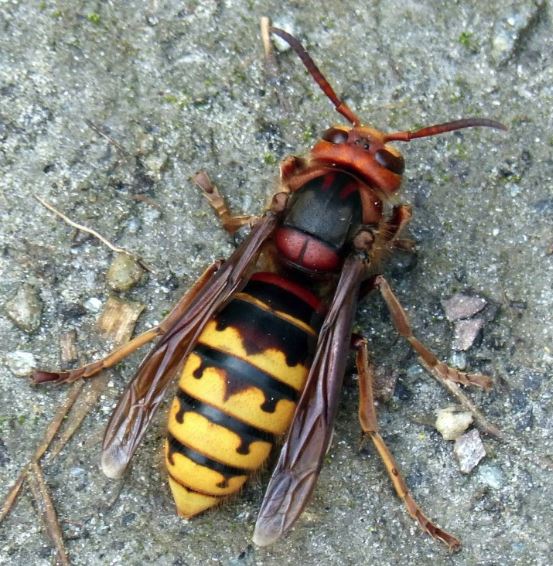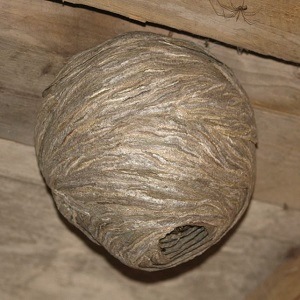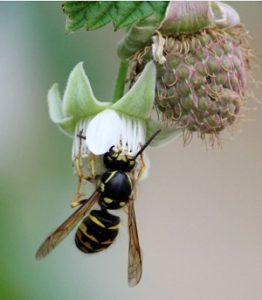Wasps – What to Expect if You have a Wasp Problem
Identification
 Wasps are known for their yellow and brown coloration. In fact, they come in many colors including black, red, and metallic blue.
Wasps are known for their yellow and brown coloration. In fact, they come in many colors including black, red, and metallic blue.
If you see a flying bee-like insect that is hairless with large jaws and a slender waist, it’s probably some form of wasp species.
Wasps have a smooth and sleek appearance. In addition to multifaceted eyes, they have triangular eyes on the top of their head.
They have large mandibles for chewing which gives them a powerful bite. Between their thorax and abdomen, they have a thin waist. All wasps have two sets of wings; the front is larger than the rear.
Stings
Wasps are much more aggressive than bees. They attack when they sense a threat to themselves, their food, or their nest.
Their sting is painful, causing swelling and redness. A wasp sting can be dangerous and possibly life-threatening to those who suffer a toxic reaction. Seek professional medical assistance whenever a person is stung.
Wasps do not lose their stinger and can sting multiple times. Only females sting, but males deliver a ferocious bite.
Wasp Removal Services Near You
Get a Croach® pest exterminator near:
Free Pest Inspection
Wasps Nests
 Wasps sometimes build nests in the ground, making them hazardous and hard to notice. If you step on one, you may be chased and attacked by hundreds more occupying that nest.
Wasps sometimes build nests in the ground, making them hazardous and hard to notice. If you step on one, you may be chased and attacked by hundreds more occupying that nest.
They also build aerial nests from fibrous materials such as wood and vegetation and will chew these materials until they are broken down into a paper-like pulp.
Each species, such as hornets and yellow jackets, are known for different wasps nest designs and locations.
The Life Cycle
There are many different species of wasp, each of varying life cycles.
 But generally, adults feed on nectar and other insects. While not the pollinators that bees are, they are responsible for the pollination of some plants. Most pollinating wasps carry pollen internally, not on their body as bees do.
But generally, adults feed on nectar and other insects. While not the pollinators that bees are, they are responsible for the pollination of some plants. Most pollinating wasps carry pollen internally, not on their body as bees do.
The life cycle typically begins with a fertile queen. She mates with a male in the fall and stores the sperm for use in fertilizing her eggs until she runs out in late summer or early the next fall.
The queen builds a small nest and lays eggs. During the larvae and pupae stages, they feed on insects provided by the queen.
Born into the colony as female workers, the new wasps continue building the nest and help provide food to the next generation of young that the queen has hatched. Males leave the nest to mate with a queen of another nest.
While wasp workers die off over the winter, queens hibernate and begin the life cycle over again in spring.
Croach® Wasp Control and Removal
Ready to get rid of wasps on your property?
Your skilled technician will treat the opening of the nest and then remove it from your home or property. Regular treatment of the eaves, base of the house, and other areas as advised by your technician prevent their return.
Wasps are attracted to a steady supply of food, including other bugs and insects. Ongoing pest control service keeps your home free of pest infestations.
Initial Inspection
A Croach® licensed pest control technician will perform a thorough inspection of your property and discuss potential problems. A customized plan for extermination and ongoing management is presented. Then your home’s interior and exterior are treated to begin pest control services.
Regular Services
Ongoing pest control and management are in your best interest for the health and safety of your home, family, and pets. We will fortify a protective barrier around the outside of your property and apply exclusion methods as needed. Your technician uses environmentally-friendly products whenever possible.
Free Retreats Guarantee
If you experience pest activity in between regularly scheduled services, Croach® will return and retreat the affected areas free of charge. If we have not fixed the problem after two retreats, we will refund your last full payment.
Whether you need wasp removal and relocation or wasp control, count on Croach® for experienced and thorough pest control services.
Related Articles
Stinging Insects
Stings, Swarms, Hives
Stinging Summer Pests
Bug Phobias
Free Pest Inspection
